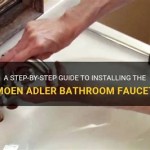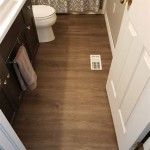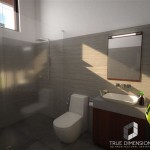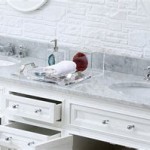Bathroom Vanities Without Predrilled Holes: A Comprehensive Guide
The selection of a bathroom vanity is a significant step in bathroom renovation or construction. Among the various options available, bathroom vanities without predrilled holes present a unique set of benefits and considerations for the homeowner. This type of vanity offers greater customization and flexibility in faucet selection and placement, but it also requires careful planning and execution during installation. This article aims to provide a detailed overview of bathroom vanities without predrilled holes, covering their advantages, disadvantages, installation considerations, and selection criteria.
Enhanced Customization and Faucet Compatibility
One of the primary advantages of a bathroom vanity without predrilled holes lies in the enhanced customization it offers. Standard vanities typically come with predrilled holes for specific faucet configurations, such as single-hole, centerset, or widespread. This can limit the homeowner's choices to faucets that match the existing hole configuration. Without predrilled holes, the homeowner has the freedom to select virtually any faucet style and configuration, regardless of the manufacturer or design.
This customization extends beyond mere aesthetic preference. It can also be a practical consideration. For instance, a homeowner might prefer a specific reach or height of a faucet spout, which may only be available in a particular configuration. Without predrilled holes, the faucet can be positioned exactly where it is most functional and visually appealing. Furthermore, choosing a unique faucet finish or design can significantly impact the overall aesthetic of the bathroom, and a vanity without predrilled holes allows for this level of design freedom.
The ability to choose any faucet also allows for greater long-term flexibility. Should the homeowner decide to replace the faucet in the future, the absence of predrilled holes means that any new faucet, regardless of its configuration, can be installed without the need to replace the entire vanity top. This can save both time and money in the long run.
Installation Considerations and Requirements
While the lack of predrilled holes offers greater customization, it also introduces additional installation considerations. The homeowner or installer is responsible for precisely drilling the necessary holes for the faucet and any accompanying accessories, such as soap dispensers or deck-mounted sprayers. This requires careful planning, accurate measurements, and the use of appropriate tools.
Before drilling, it's crucial to determine the desired faucet placement. Consider the size and shape of the sink basin, the reach of the faucet spout, and the overall design of the vanity. It’s often recommended to create a template or mock-up to visualize the faucet placement before drilling any holes. This helps to avoid costly mistakes and ensures that the final result is aesthetically pleasing and functionally sound.
The type of material used for the vanity top will also influence the drilling process. Solid surface materials like granite or quartz require specialized drill bits designed for hard materials. The drilling process should be slow and steady, using water or other cooling agents to prevent overheating and cracking. Laminate or wood vanity tops are typically easier to drill, but care should still be taken to avoid splintering or chipping the surface.
Another key consideration is the plumbing. Ensure that the location of the faucet holes aligns with the existing plumbing connections under the sink. It's important to have sufficient space for the water supply lines and drain to connect properly to the faucet. Consulting with a plumber during the planning phase can help to avoid potential plumbing issues down the line.
Safety is paramount during the drilling process. Always wear safety glasses to protect the eyes from debris. Use appropriate clamping devices to secure the vanity top and prevent it from moving during drilling. If unfamiliar with drilling into specific materials, it's recommended to consult with a professional installer to avoid damaging the vanity top or causing injury.
Material Selection and Vanity Construction
The material used for the vanity top is a significant factor when selecting a bathroom vanity without predrilled holes. Different materials offer varying degrees of durability, water resistance, and aesthetic appeal. Common options include granite, quartz, marble, solid surface materials, laminate, and wood.
Granite is a natural stone known for its durability and resistance to scratches and heat. It offers a unique and luxurious look, with variations in color and veining. However, granite is porous and requires sealing to prevent staining. Drilling into granite requires specialized diamond-tipped drill bits and a slow, steady approach.
Quartz is an engineered stone that offers similar durability to granite but with greater consistency in color and pattern. It is also non-porous, making it more resistant to staining and bacteria growth. Quartz is generally easier to fabricate and drill than granite, but still requires specialized drill bits.
Marble is another natural stone that offers a classic and elegant look. However, marble is softer and more porous than granite and quartz, making it more susceptible to scratches and stains. It requires frequent sealing and careful maintenance. Drilling into marble requires a gentle approach to avoid cracking or chipping the stone.
Solid surface materials, such as Corian, are non-porous and seamless, making them easy to clean and maintain. They are also relatively easy to fabricate and drill, offering greater flexibility in design and installation. Solid surface materials are available in a wide range of colors and patterns.
Laminate is a cost-effective option that consists of a thin layer of decorative material bonded to a substrate, such as particleboard or MDF. Laminate is relatively durable and water-resistant, but it is susceptible to scratches and damage from heat. Drilling into laminate requires care to avoid splintering or chipping the surface.
Wood vanities offer a warm and natural look. Solid wood is durable and can be refinished if damaged. However, wood is susceptible to water damage and requires proper sealing and maintenance. Drilling into wood is generally easier than drilling into stone or solid surface materials, but care should be taken to avoid splitting the wood.
The construction of the vanity is also an important consideration. Look for vanities with solid wood frames and durable hardware. Check the quality of the drawers and doors, ensuring that they operate smoothly and close securely. The finish on the vanity should be durable and resistant to moisture.
Consider the overall style of the bathroom when selecting a vanity. Modern bathrooms often feature sleek, minimalist vanities with clean lines and simple hardware. Traditional bathrooms may incorporate more ornate vanities with detailed carvings and decorative hardware. The vanity should complement the other elements in the bathroom, such as the flooring, tile, and fixtures.
Benefits of Professional Installation
While it's possible for a homeowner to install a bathroom vanity without predrilled holes, hiring a professional installer offers several advantages. A professional installer has the experience, tools, and expertise to ensure that the vanity is installed correctly and safely.
Professional installers are familiar with the various types of vanity materials and the appropriate drilling techniques for each material. They can accurately measure and position the faucet holes, ensuring that the faucet is properly aligned and that the plumbing connections are secure.
A professional installer can also handle any unexpected issues that may arise during the installation process. For example, if the existing plumbing is not compatible with the new vanity, they can make the necessary modifications to ensure that the plumbing is properly connected.
Hiring a professional installer can also save time and effort. Installing a bathroom vanity can be a time-consuming and physically demanding task. A professional installer can complete the installation quickly and efficiently, allowing the homeowner to focus on other aspects of the bathroom renovation.
Perhaps the most important benefit of hiring a professional installer is the peace of mind that comes with knowing that the vanity has been installed correctly. This can help to prevent future problems, such as leaks or water damage, which can be costly to repair.
When selecting a professional installer, it's important to choose someone with experience in installing bathroom vanities and with a good reputation. Check online reviews and ask for references. It's also a good idea to get a written estimate before hiring an installer, so you know exactly what to expect in terms of cost.

ᐅ Woodbridge Venice 36 X21 X33 Solid Wood Bath Vanities Side Cabinet In Grey And Brushed Nickel Trim Carrara Marble Vanity Top With 3 Pre Drilled Holes For 4 Inches Centerset Faucet

36 Roman Style Bathroom Vanity Base Without Sink Pre Drilled Holes Storage Cabinet With Open Shelf And 2 Drawers For Com

ᐅ Woodbridge Venice 42 X21 X33 Solid Wood Bath Vanities Side Cabinet In Grey With Goldl Trim And Engineered Stone Composite Vanity Top Dark Gray 3 Pre Drilled Holes For 4 Inch Centerset Faucet

30 Single Bathroom Vanity Top With White Basin 3 Faucet Holes Ceramic Predrilled Without Cabinet Com

ᐅ Woodbridge Roma 43 X22 X38 Solid Wood Bath Vanity In White With Gold Hardware And Dark Gray Engineered Stone Composite Top 3 Pre Drilled Holes 4221 Dgvt4322d 8

Upiker Modern 18 In W X 24 D 20 5 H Wall Hung Bath Vanity Cabinet Without Top Light Oak Up2208bcl24002 The Home Depot

Sarah 1000mm Vanity Unit In Slate Grey Inc Worktop With No Tap Holes Interiors Home S

Lauren Bathroom Vanity With Sink And Carrara White Marble Top Cabinet Ancerre Designs

Ariel Hamlet 48 In White Bathroom Vanity Base Cabinet Without Top The Vanities Tops Department At Com

Alaterre Furniture Williamsburg 36 In W X 21 D 34 H Bath Vanity Cabinet Without Top White Avan36whbb The Home Depot
Related Posts







